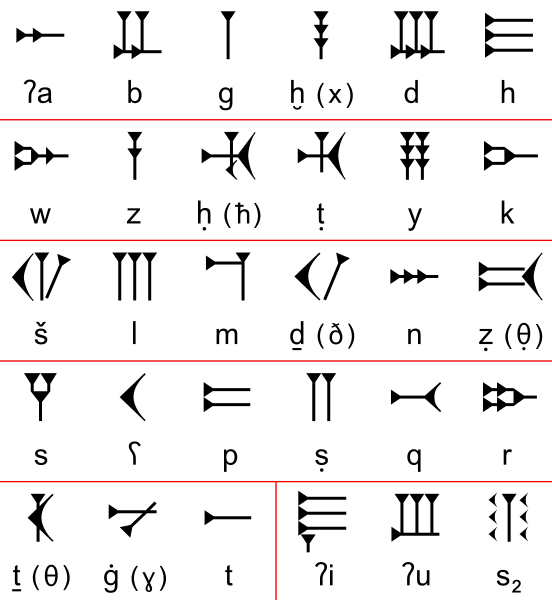Dosiye:Ugaritic-alphabet-chart.svg

Size of this PNG preview of this SVG file: 552 × 600 pixels. Indi ingano zagutse: 221 × 240 pixels | 442 × 480 pixels | 707 × 768 pixels | 942 × 1.024 pixels | 1.884 × 2.048 pixels | 622 × 676 pixels.
Dosiye nyirizina (SVG file, nominally 622 × 676 pixels, file size: 28 KB)
Amateka ya dosiye
Kanda kwitariki/n'isaha kugirango ufungure dosiye nkuko yagaragaye cyagihe.
| Itariki/Isaha | Ifoto ntoya | Ibipimo | Umukoresha | Comment | |
|---|---|---|---|---|---|
| muri iki gihe | 14:23, 13 werurwe 2012 |  | 622 × 676 (28 KB) | AnonMoos | tweaking crossbar of ħ |
| 01:13, 9 werurwe 2012 |  | 622 × 676 (28 KB) | AnonMoos | Table of letters of the Ugaritic cuneiform alphabet, with a conventional transcription. Where the "Semitological" symbols are somewhat divergent from the IPA symbol for the letter's probable pronunciation, the I... |
Ikoreshwa rya dosiye
Ibi bikurikira abakoresha urupapuro iyi dosiye:
Ikoreshwa rya dosiye rusange
Izindi wiki zikurikira zikoresha iyi dosiye:
- Ikoreshwa kuri af.wikipedia.org
- Ikoreshwa kuri am.wikipedia.org
- Ikoreshwa kuri ar.wikipedia.org
- Ikoreshwa kuri ast.wikipedia.org
- Ikoreshwa kuri be.wikipedia.org
- Ikoreshwa kuri bg.wikipedia.org
- Ikoreshwa kuri ca.wikipedia.org
- Ikoreshwa kuri de.wikipedia.org
- Ikoreshwa kuri el.wikipedia.org
- Ikoreshwa kuri en.wikipedia.org
- Ikoreshwa kuri en.wiktionary.org
- Ikoreshwa kuri eo.wikipedia.org
- Ikoreshwa kuri es.wikipedia.org
- Ikoreshwa kuri fa.wikipedia.org
- Ikoreshwa kuri fr.wikipedia.org
- Ikoreshwa kuri gl.wikipedia.org
- Ikoreshwa kuri got.wikipedia.org
- Ikoreshwa kuri he.wikipedia.org
- Ikoreshwa kuri id.wikipedia.org
- Ikoreshwa kuri it.wikipedia.org
- Ikoreshwa kuri ja.wikipedia.org
- Ikoreshwa kuri kk.wikipedia.org
- Ikoreshwa kuri ko.wikipedia.org
- Ikoreshwa kuri lfn.wikipedia.org
- Ikoreshwa kuri ml.wikipedia.org
- Ikoreshwa kuri nl.wikipedia.org
- Ikoreshwa kuri no.wikipedia.org
- Ikoreshwa kuri pl.wikipedia.org
- Ikoreshwa kuri ru.wikipedia.org
- Ikoreshwa kuri sl.wikipedia.org
- Ikoreshwa kuri sr.wikipedia.org
- Ikoreshwa kuri sv.wikipedia.org
- Ikoreshwa kuri th.wikipedia.org
- Ikoreshwa kuri uk.wikipedia.org
- Ikoreshwa kuri uz.wikipedia.org
- Ikoreshwa kuri zh.wikipedia.org

